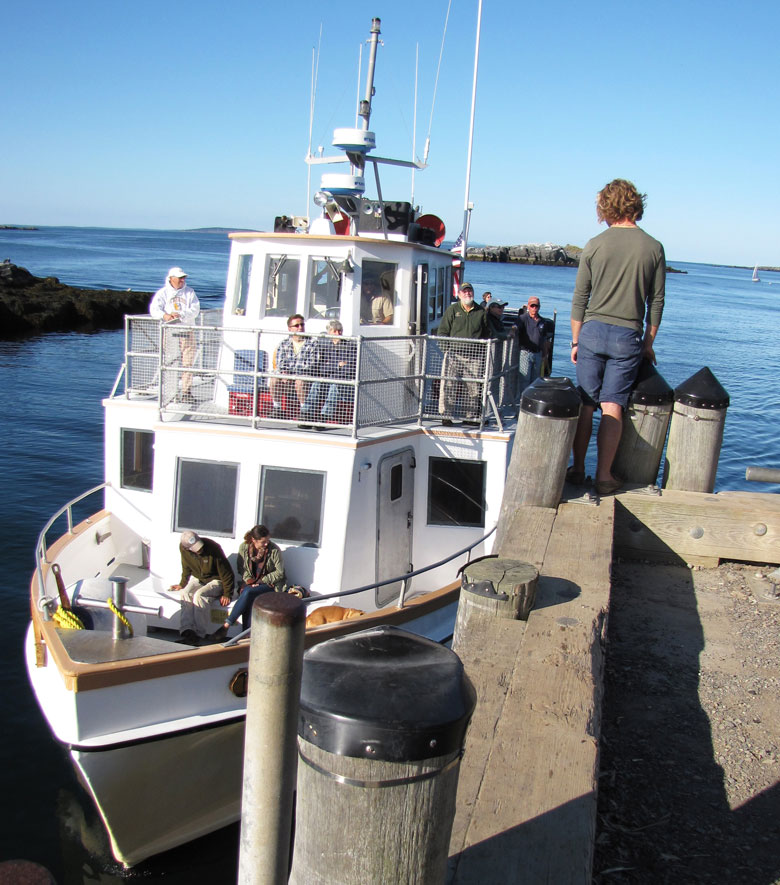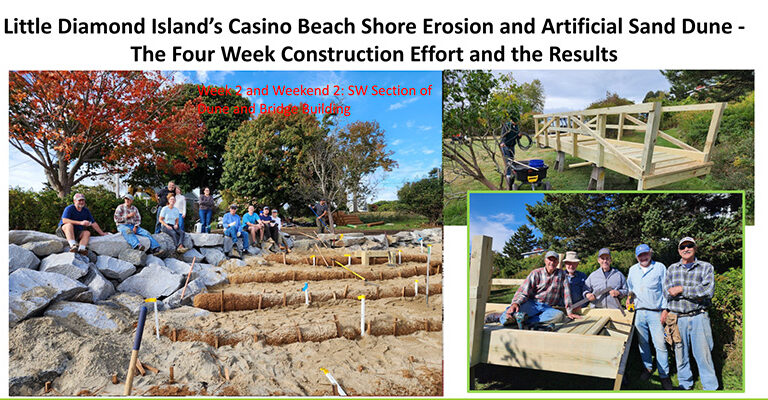Reflections is written by Island Fellows, recent college grads who do community service work on Maine islands and in coastal communities through the Island Institute, publisher of The Working Waterfront.
I love the challenge of staying in the fleeting, low-angled rays of winter sun on Monhegan Island and considering my layering as part of the island’s ecology. I have only been here for a few months and already feel weathered as the winds build and plein air painters fully disappear.
The crashing waves draw my eye while the talk of the town shifts between the ferry schedule and whether with the next storm the water will surge up to last winter’s heights.
Last year’s January storms overtopped the small breakwater protecting Fish Beach, the fishing community’s only access to their moorings. There is a lingering memory of the powerful waves washing debris along the waterfront, into the roads, and swiping the plumbing systems from beneath the harbor’s coastal homes.
The main thing I am considering is how the changes will last for generations…
My position is to manage grant writing and waterfront infrastructure projects. Coming into a small community “at speed” and joining long-term projects that others have managed for years feels a bit like rifling through a friend’s pockets while you walk together down the road.
Facing the community now is the decision of how to move forward—forward toward a response to the increasingly powerful winter storms and the growing summer traffic. The main thing I am considering is how the changes will last for generations and affect the function of the island in every season.
Although I have not seen the summer rush, there are two schools of thought: either raise and widen the public wharf or build a new breakwater. A rebuilt wharf would stand taller by four and a half feet with a concrete panel surface.
The wharf would be resistant to winter overtopping with a smooth working surface. It would also be equipped with a crane that would allow freight loads, like firewood or the occasional tuna, to be lifted from a docked vessel. The wider wharf could also accommodate the traffic from both summer businesses (with their seven trucks) and day-trippers (whose numbers are in the many hundreds).
For an island that stands out on the Maine coast for its accessible natural beauty, the wharf would stand out on the island as a modernization that alleviates a simple bottleneck by forever changing the harbor’s appearance.

The alternative could be to build a new breakwater, with the goal of completely or partially enclosing the harbor on the southwestern opening, protecting the entire harbor from harsh sea conditions year-round. The breakwater would rebuff the force of the strong southerly storms, which have a “fetch” that stretches for hundreds of miles, thus protecting the summer and year-round waterfront homes within Monhegan Harbor.
A safe harbor would make for an enticing landing site for the Monhegan Boat Line, which is the only year-round private boat line that holds the postal contract for the island. The ferries, which from January to March run only twice a week, are often canceled with any small craft advisory. The cancellations are not just dependent on the rough seas in open water (the vessels are seaworthy enough), but on the wave action that occurs while landing at the other end of the trip within Monhegan Harbor.
The fishermen are also restricted by the weather. At the right wind and wave angle, the vessels in the mooring field become virtually inaccessible in small craft like the plywood dinghies. A breakwater would transform the harbor and the way water moves through it.
The change would be a permanent improvement for the lives of those making a living working on the water and for any vessel that needs to tuck into Monhegan Harbor.
To see the island for its people: Monhegan is riding a fine line between the beauty captured in Eliot Porter’s “Summer Island,” which draws tens of thousands in the summer, and one that is in need of critical infrastructure to function as a home for a few and a sacred place for many.
Thomas McClellan works with Monhegan Plantation on a working waterfront resiliency project. Originally from Maine, Thomas recently completed a degree in sustainability and oceanography at Dalhousie University in Nova Scotia.





